|
Answers - Work and Energy
|
|
|
1.
|
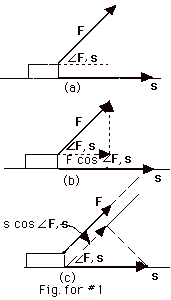
Work equals the force F times the displacement s times the cosine
of the angle  F,s
between the force F and the displacement s: F,s
between the force F and the displacement s:
W = (Fs cos  F,s) F,s)
If we rewrite work as
W = (F cos  F,s)s F,s)s
we see from Fig. 1b above that we may say, alternatively, that
work is the component of the force, F cos  F,s,
in the direction of the displacement times the displacement.
From Fig. 1c above we find we may also write F,s,
in the direction of the displacement times the displacement.
From Fig. 1c above we find we may also write
W = F (s cos  F,s) F,s)
or work is the product of the force and the component of the
displacement,
(s cos  F,s),
in the direction of the force. F,s),
in the direction of the force.
|
|
|
|
|
3.
|

If you do not raise the object or increase its velocity, there
is no increase in the object’s potential energy or in
its kinetic energy. The physicists’ definition of work
demands that when you do work on an object its energy increases.
For the situation in Fig. 1 above, you are exerting a force
through a distance, but you do no work. For this reason, we
define work W as the force F times the displacement s times
the angle between F and s or  F,s.
In Fig. 1, F,s.
In Fig. 1,  F,s
= 90o and cos 90o = 0. With this definition
of work, we correctly predict that no work is done by moving
an object horizontally without increasing its speed. You may
tire while moving the object because your tensed muscles are
continually contracting and relaxing in minute movements. You,
however, have done no work on the object as defined in a physical
sense. F,s
= 90o and cos 90o = 0. With this definition
of work, we correctly predict that no work is done by moving
an object horizontally without increasing its speed. You may
tire while moving the object because your tensed muscles are
continually contracting and relaxing in minute movements. You,
however, have done no work on the object as defined in a physical
sense.
|
|
|
4.
|
The force that produces a centripetal acceleration is always
in toward the center or perpendicular to the path. The angle
between the tension and the displacement is 90o.
Since cos 90o = 0, no work is done by the tension
in the string. Also note that the potential energy and the
kinetic energy of the object does not change.
|
|
|
5.
|

- The angle between F and s is 0o.
The work done by F = Fs cos 0o = 12 N(4 m)(1)
= 48 J.
- The angle between FN and s is
90o.
The work done by FN = FNs cos 90o
= FNs(0) = 0.
- The angle between mg and s is -90o.
The work done by mg = mgs cos -90o = mgs(0) =
0.
- To find the frictional force f, notice that:
(Fnet)y = may = m(0) =
0
FN - mg = 0 and FN = mg
f = µkFN = 0.50(mg) = 0.50(20
N) = 10 N.
The angle between f and s is 180o.
The work done by f = fs cos 180o = 10 N(4 m)(-1)
= - 40 J.
- The work done by the net force = 48 J - 40 J = 8 J or
(Fnet)x = 12 N - 10 N = 2 N.
Work done by net force = 2 N(4 m)cos 00 = 8 J.
|
|
|
6.
|
 For the raindrop to fall with a constant speed, the net force
acting on the drop must equal 0. Thus mg - f = 0 or mg = f,
where f is the frictional force of the air on the drop and
I have taken down as positive. Work = Force(displacement)
For the raindrop to fall with a constant speed, the net force
acting on the drop must equal 0. Thus mg - f = 0 or mg = f,
where f is the frictional force of the air on the drop and
I have taken down as positive. Work = Force(displacement)
 F,s.
The gravitational force mg is in the same direction
as the displacement s. F,s.
The gravitational force mg is in the same direction
as the displacement s.
Work by gravitational force equals:
mgs cos 0o = mgs = 3.35 x 10-5 kg(10
m/s2)(100 m)(1) = 3.35 x 10-2 J.
The frictional force of the air is opposite to the direction
of the displacement s. Work by frictional force of
air = fs cos 180o = -3.35 x 10-2 J.
|
|
|
7.
|
Kinetic energy K = 1/2 mv2
= 1/2(52 kg)(14.0 m/s)2 = 51 x 102 J.
|
|
|
8.
|
- v • v = (v)(v)
cos
 v,
v = v2 cos 0o = v2(1)
= v2. v,
v = v2 cos 0o = v2(1)
= v2.
- d(v • v) = v •
dv + dv • v = 2v •
dv because the order of the vectors in a dot or scalar
product does not matter. The scalar product is commutative.
d(v2) = 2v dv. Since v •
v = v2, d(v • v)
= d(v2) = 2v dv.
|
|
|
9.
|
- Work done by net force =
(Fnet) x cos 00 = (ma)x.
(Equation
1)
For motion along the x axis with constant acceleration,
vf2 = vo2
+ 2ax or
ax = 1/2(vf2 - vo2)
(Equation
2).
Substituting ax from Eq. 2 into Eq. 1: Work done by net
force
= m{1/2(vf2 - vo2)}
= 1/2 mvf2 - 1/2 mvo2
= change in kinetic energy.
- ∫ Fnet
• ds
= ∫ m dv/dt • ds = ∫ m dv/dt • v dt = m∫
v • dv
In the above equation, we have used the definition ds
= v dt and the result of #8 that v •
dv = v dv.
|
|
|
10.
|
Work done by net force = 8 J = 1/2 (2.0
kg)vf2 - 1/2 (2.0 kg)vo2.
8 J = 8 N-m = 8 kg(m/s2)(m) = 1 kg vf2
- 1/2 (2.0 kg)(0) or
vf = 2(2)1/2 m/s.
|
|
|
|
|
12.
|
From work energy theorem,
Work done = 1/2 mvB2 - 1/2
mvA2
From #11,
mgh = 1/2 mvB2 - 1/2 mvA2
vB = (2gh + vA2)1/2
|
|
|
|
|
|
|
15.
|
Work = force(displacement) cos F,s F,s
- The angle between the force exerted by the person and
the displacement is 0o. Work by person
=10 N(1.0 m) = 10 J.
- The gravitational force = mg = 1.0 kg(10 m/s2)
= 10 N. To lift the object with a constant velocity the
force of the person must be equal in magnitude to the gravitational
force. The angle between mg and s is 180o.
Work done by gravity = 10 N(1.0 m)cos 180o =
-10 J.
- Increase in potential energy = mgh, where h is the height
to which the object is raised = 10 J. The increase in the
potential energy equals the work done by the person in raising
the object with a constant velocity or it equals the negative
of the work done by the gravitational force.
- The increase in kinetic energy is zero because the work
done by the net force is zero.
|
|
|
16.
|
- Now work done by person = 12 N(1.0 m) = 12 J.
- Work done by gravitational force still equals -10 J.
- Increase in potential energy equals the negative of the
work done by the gravitational force = 10 J.
- Work done by the net force = 12 J - 10 J = 2 J = increase
in kinetic energy.
|
|
|
17.
|
- Work done by friction = fs cos 180o= 72 N(3.0
m)(-1) = -216 J.
- Work by net force = work done by friction = change in
kinetic energy
-216 J = 1/2 (12 kg)v23.0m -
1/2(12 kg)(10 m/s)2
-216 J + 600 J = 1/2(12 kg)v23.0m.
V3.0m = 8.0 m/s2.
- Work done by friction = 72 N(s)(-1) = change in kinetic
energy = 0 - 600 J.
s = 8.3 m
|
|
|
18.
|

For the figure above,
- sine of the angle of incline = 1.0/2.0. Angle of
incline = 30o. For motion of the object
with constant velocity, the net force in that direction
must be zero.
Fnet up the plane = ma = m(0)
F - mg sin 30o = 0 Force of
person =
F = mg sin 30o = 2.0 kg(10 m/s2)(1/2)
= 10 N.
The angle between the force of the person and the displacement
is 0o. Work done by person in moving the object
up the plane of 2.0 m with a constant velocity = 10 N(2.0
m)(cos 0o) = 10 N(2.0 m)(1) = 20 J.
- The component of the force of gravity down the plane is
mg sin 30o = 10 N.
The angle between this component and the displacement up
the incline is 180o. The work done by the
gravitational force =
(10 N)(2.0 m)(-1) = -20 J.
The work done by the net force = work done by person + work
done by gravitational force = increase in kinetic energy.
Work done by person =
increase in kinetic energy - work done by gravitational
force
= {1/2 (2.0 kg)(3.0 m/s2)2 - 0} -
(-20 J) = 29 J.
- Again, Fnet up the plane = ma = m(0) = 0,
but now there is a frictional force of 3.0 N so that F -
mg sin 30o - 3.0 N = 0, or F = 13 N. Work
done by person = 13 N(2.0 m)(1) = 26 J.
|
|
|
19.
|

Take Uf at the bottom of the incline = 0.
Work done by friction = fs cos 180o = (Uf
+ Kf) - (Ui + Ki).
f(125 m)(-1) = {0 +(1/2)(1.0 kg)(25 m/s)2} - {1.0
kg)(10 m/s2)(62.5 m) + 0}.
-125 m f = 312.5 J - 625 J = -312.5 J.
f = 2.5 N
|
|
|
20.
|
The total energy E = U + K or
K = E - U = {-21.7 - (-43.4)}10-19 J.
K = 21.7 x 10-19 J. While the total and potential
energy are negative, classically the kinetic energy must always
be positive.
|
|
|
21.
|
- Acceleration a = Dv/Dt
= (0.20 - 0)m/s/0.50 s = 0.40 m/s2.
F = ma = 2000 kg(0.40 m/s2) = 800 N.
- K = 1/2(2000 kg)(0.20 m/s)2 = 40 J.
- Work done by net force = change in kinetic energy = 40
J.
- Work = Fs = 800 N s = 40 J. s = 40 J/800 N
= 0.05 m.
|
|
|
22.
|
- i . i = (1)(1) cos 0o =
1
- i . j = j . i = (1)(1)
cos 90o = 0
- j . j = (1)(1) cos 0o =
1
- W = F . s = 20 N j .
4 m i = 80 J(j . i) = 0
- W = F . s= (3i + 4j)N
. (2i - 2j)m
= 6J(i . i) - 6J(i . j)
+ 8J(j . i) - 8J(j . j)
= 6 J - 0 + 0 - 8 J = -2 J
|
|
|
23.
|

Work done = ∫Fx dx = area under curve.
I have added the calculations of the areas to Fig. 4 above.
As shown in the figure,
- the work done from x = 0 to x = 1.0 m is 4.0 J,
- the work done in going from x = 1.0 m to x = 2.0 m is
2.0 J + 4.0 J = 6.0 J, and
- the work done in going from x = 2.0 m to x = 3.0 m is
4.0 J. From the work-energy theorem the work done
equals the change in kinetic energy.
- From x = 0 to x = 1.0 m, work done = 4.0 J = 1/2
mv12 - 0, since vo = 0.
4.0 J = 1/2(2.0 kg)v12 or
v1 = 2.0 m/s.
- From x = 1.0 m to x = 2.0m, work done = 6.0 J =
1/2 mv22 - 1/2 mv12
= 1/2(2.0 kg)v22 - 1/2(2.0 kg)(4.0
m2/s2) or
6.0 J = 1 kg v22 - 4.0 J.
6.0 J + 4.0 J = 10 J = 10 kg(m/s)2 = 1.0 kg v22
and
v2 = (10)1/2 m/s.
- From x = 2.0 m to 3.0 m, work done = 4.0 J = 1/2 mv32
- 1/2 mv22
4.0 J = 1/2(2.0 kg)v32 -
10 J
14 J = 1/2(2.0 kg)v32 and
v3 = (14)1/2 m/s.
|
|
|
24.
|
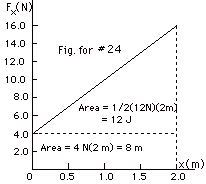
dW = F . ds = (4.0 N + 6.0 N/m x)i
. dx i = (4.0 N + 6.0 N/m x)dx since i
. i = 1.

You can also find the work done from the area under the curve
of Fx as a function of x, as is shown in the Fig.
for #24 above.
|
|
|
25.
|
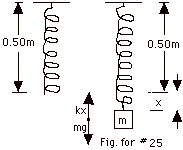
When the mass m = 0.50 kg is attached to the spring and it comes
to rest,
Fnet = ma = m(0).
For up positive, kx - mg = 0 or (50 N/m)x - (0.50 kg)(10 m/s2)
= 0
and x = 5.0 N/(50 N/m) = 0.10 m.
The new equilibrium length = (0.50 + 0.10)m = 0.60 m.
|
|
|
26.
|
- Fnet = ma
T = mv2/r = (1.0 kg)(1.0 m/s)2/1.0
m = 1.0 N
- The tension equals the force due to the spring = kx =
1.0 N,
where x = R - relaxed length = 1.0 m - 0.9 = 0.1 m.
k = 1.0 N/x = 1.0 N/0.1 m = 10 N/m
- Now kx’ = mv’2/R’ or
(10 N/m)(R’ - 0.9 m) = 1.0 kg(2.0 m/s)2/R’
or
10 N/m (R’)(R’ - 0.9 m) = 4.0 N-m
10 R’2 - 9 R’ m - 4.0 m2
= 0.
R’ = {9m ± (81 m2 + 160 m2)1/2}/20
= 1.23 m.
- Work to increase the kinetic energy of the mass
= 1/2 m(v’2 - v2)
= 1/2 (1.0 kg)(4.0 - 1.0)m2/s2 = 1.5
J
x’ = R’ - R = 1.23 m - 1.00 m = 0.23 m
Work to stretch spring
= 1/2 k(x’2 - x2)
= 1/2(10 N/m)(0.053 - 0.010) = 0.21 J.
Total work done = (1.5 + 0.2)J = 1.7 J
|
|
|
27.
|
- Fc . ds = -kx2
i . dx i = -kx2 dx.

- Let xi = 0 and
Ui = 0, xf = x and
Uf = U.
Then U(x) = 1/3 kx3.
|
|
|
28.
|
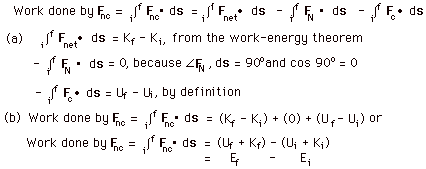
where E = the total mechanical
energy.
(c) If the nonconservative force Fnc = 0,
| Ef |
= |
Ei and |
| Uf
+ Kf |
= |
Ui + Ki |
|
|
|
29.
|

Since the incline is frictionless and no other nonconservative
force acts on the object, energy is conserved. Take the initial
point i at the top of the incline and the final point f at the
bottom of the incline. Let Uf = 0. At the initial
point the potential energy is mgh, where h is the vertical
height above the bottom of the incline. The object being
released from the top of the incline means that its initial
velocity vi is zero so that Ki
= 1/2 mvi2 = 0. From conservation
of energy,
Ui
+ Ki = Uf + Kf
2.0 kg(10 m/s2)(3 m) + 0 = 0 + 1/2(2.0 kg) vf2
60
m2/s2 = vf2 or
vf
= (60)1/2 m/s = 7.7 m/s
|
|
|
|
|
31.
|
Now take at bottom of incline,
Ui = 0 and Ki = 60 J.
After the spring has maximum compression,
Uf = 1/2 kx2 =1/2(480 N/m)x2 and
Kf = 0.
0 + 60 J = 240 N/m x2 + 0. x2
= 1/4 m2 and
x = 1/2 m.
|
|
|
32.
|
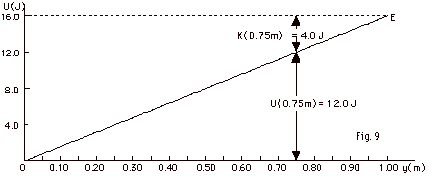
- From Fig. 9 above, at y = 0.750 m, U = 12.0 J.
- Since at all times E = 16.0 J = U + K = U(0.750m) + K(0.750
m) =
12.0 J + K(0.750 m) or
K(0.750m) = 4.0 J.
- U = mgh or,
at 0.750 m, 12.0 J = m(10 m/s2)(0.75 m) or
m = 1.6 kg.
- K = 1/2 mv2 = 1/2(1.6kg)v2 = 4.0
J or
v = (5)1/2 m/s.
|
|
|
33.
|
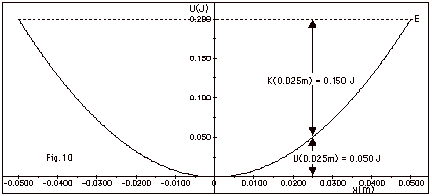
- From Fig. 10 above, at x = 0.025 m, U = 0.050 J.
- E = 0.200 J = U + K = 0.050 J + K. K = 0.150
J.
- U = 0.050 J = 1/2 kx2= 1/2 k(0.025 m)2
or
k = 0.10 J/6.25 x 10-4 m2 = 160 N/m.
- K = 0.150 J = 1/2 mv2 = 1/2(0.30kg)v2
or
v2 = 2(0.150)/0.30 m2/s2
= 1.0 m2/s2 or
v = 1.0 m/s.
- E = 0.200 J =1/2 kxmax2 = 1/2
(160 N/m)xmax2 or
xmax = (25 x 10-4)1/2m
= 0.05m.
- v is a maximum when the potential energy is a minimum.
This occurs for x = 0 and, therefore, U = 0
with K = E = 0.200 J = 1/2 mvmax2
= 1/2(0.30kg)vmax2.
vmax = 1.15 m/s.
|
|
|
34.
|
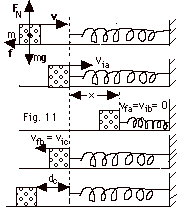
- (Fnet)y = may = m(0)
= 0
FN - mg = 0 or FN = mg
f = µkFN = µkmg
Work done by f = fs cos  f,
s = fx cos 180o f,
s = fx cos 180o
= µkmgx(-1) = -0.30(1.0 kg)(10 m/s2)x
Work done by friction = (Uaf + Kaf)
- (Uai + Kai)
-3.0x N = (1/2 kx2 + 0) - (0 + 1/2 mvia2)
-3.0xN = 1/2 (10N/m x2) - 1/2 (1.0 kg)(16 m2/s2)
-3.0x m = 5.0x2 - 8.0 m2. 5.0x2
+ 3.0x m - 8.0 m2 = 0
x = {-3.0 m ± (9 m2 +160 m2)1/2}/10
and x = 1.0 m
- Work done by friction = (Ubf + Kbf)
- (Ubi + Kbi)
-3.0xN = (0 + 1/2 mvbf2) - (1/2 kx2
+ 0)
-3.0(1.0 m)N = 1/2(1.0 kg)vbf2 - 1/2(10N/m)(1.0
m)2
-3.0 J = 1/2 kg vbf2 - 5.0
J or
2.0 J = 1/2 kg vbf2 and
4.0(m/s)2 = vbf2
vbf = 2.0 m/s
- Work done by friction = (Ucf + Kcf)
- (Uci + Kci)
-3.0dcN = (0 + 0) - (0 + 1/2 mvci)
= -1/2 (1.0 kg)(4.0 m2/s2) = -2.0
J
dc = 2/3 m
|
|
|
35.
|
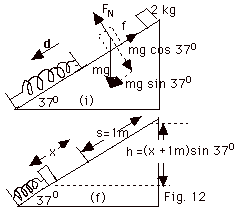
- I took the gravitational potential energy = Ugf
= 0 at the final position.
- This makes the initial gravitational potential energy
(see Fig. 12f above) equal mgh, where h = (x + 1 m)sin 37o.
Ui = 20N(x + 1m)3/5 = 12N(x + 1m).
- Ki = 0 because the block is released from
rest.
- In Fig. 12i above, taking the Y-axis perpendicular to
the plane,
(Fnet)y = may
FN - mg cos 37o = m(0) = 0 or
FN = mg cos 37o = 20 N (4/5) = 16
N
f = µFN = 1/8(16 N) = 2.0 N.
- While in the final position, the gravitational potential
energy is zero, the spring potential energy = 1/2 kx2
=1/2(120 N/m)x2 = 60 N/m x2.
- When the spring has maximum compression, the block comes
to rest
so Kf = 0.
- Work done by frictional force = f . d
= fd cos 180o = -(2N)(x + 1 m).
- Work done by
f = (Uf
+ Kf) - (Ui + Ki)
| -2.0
N(x + 1m) |
= |
(60 N/m x2
+ 0) - {(12N)(x + 1m) + 0} |
| 10
N(x + 1m) |
= |
10x N + 10J = 60
N/m x2 or |
| 6.0
x2 - 1.0x m -1.0 m2 |
= |
0 or |
| x2
- (1/6) x m - 1/6 m2 |
|
|
| and
(x - 1/2 m)(x + 1/3 m) |
= |
0 |
| or
x = 1/2 m |
|
|
|
|
|
36.
|

- We use conservation of energy to solve the problem. We
take the gravitational potential energy equal to 0 at the
bottom of the loop-the-loop (Fig. 13 above). The block is
released at the initial position i so the kinetic energy
there is zero. The block will make it around the loop-the-loop
if it can stay on the loop as it gets to the top of the
loop. For this reason we take the top of the loop as the
final position f.
Ui + Ki =
Uf + Kf
mgh + 0 = 2mgR + 1/2 mvf2 or
mgh = 2mgR + 1/2 mvf2
(Equation
1)
At the top, the acceleration is in toward the center.
Fnet
= ma or
mg + FN = mvf2/R
For the minimum height h, we want the minimum velocity vf,
so we set the normal force FN = 0. Then,
mg = mvf2/R or
mvf2 = mgR (Equation
2)
Substituting Eq. 2 into Eq. 1:
mgh = 2mgR + mgR = 5/2 mgR or
h = 5R/2
- At P, the potential energy = mgR.
Ui
+ Ki = UP + KP or
mg(5/2 R) + 0 = mgR + 1/2 mvP2
or
mg(3/2)R =1/2 mvP2 or
mvP2 = 3mgR
At P, the normal force produces the centripetal acceleration
into the center of the circle. At P, mg is
down.
Fnet = ma
FN = mvP2/R = {3mgR}/R
= 3mg
|
|
|
37.
|
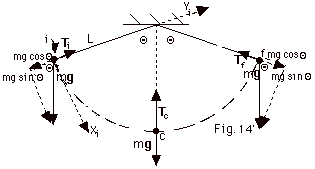
In Fig. 14’ above, I show the forces acting on the bob.
One force is the tension in the string. This force is always
in toward the center of the arc. The other force is the weight
of the bob mg. At point i and f, mg is neither away from the
center of the circle nor tangent to the arc, so we take components
of mg. At c, T is up and mg is down. In Fig. 14’ at the
initial point i, I have drawn Xi and Yi axes.
I take the Y axis in the direction of the centripetal acceleration.
There is also an acceleration in the X direction, because there
is an increase in the magnitude of the velocity. Later we shall
refer to this as the tangential acceleration.
At i (Fnet)y
= may
Ti - mg cos Q=
mvi2/L = m(0)/L,
because the object is at rest at i. Then, Ti = mg
cos Q. If you look at Fig.
14’, you see that Tf = mg cos Q
because vf also equals zero. In both cases, for the
tangential direction,
(Fnet)x = matangential
or
- mg sin Q= matangential
At c, Tc is in toward the center of the circle and mg is away
from the center. Taking the positive direction as that of the
centripetal acceleration in toward the center of the circle,
Fnet = ma
Tc - mg = mvc2/L
or
Tc
= mg + mvc2/L
(Equation
1)
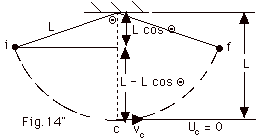
Clearly to find Tc , we must find vc.
We turn to conservation of energy. We set the potential
energy = 0 at the lowest point so that Uc = 0. The
method of finding the height of point i above c is shown in
Fig. 14” immediately above. L is the hypotenuse of the
triangle in Fig. 14” and the side adjacent is L cos Q.
The height of i above c is then L - L cos Q
= L(1 - cos Q). From
conservation of energy,
Ui
+ Ki = Uc + Kc
mgL(1 - cos Q) + 0 = 0
+ 1/2 (m)(vc)2 or
mvc2/L
= 2mg(1 - cos Q) (Equation
2)
Substituting Eq. 2 into Eq. 1,
Tc = mg + 2mg(1 - cos Q)
= mg(3 - 2 cos Q)
|
|
|
38.
|

- Start with conservation of energy because we are told
the surface is frictionless.
Ui
+ Ki = Ut + Kt
. Taking Ui = 0,
0 + 1/2(mvo2) = 2mgR + 1/2 mvt2,
where t is at the top of the circle, a distance of 2R
above i.
mvo2
= mvt2 + 4mgR (Equation
1)
What does it mean that "m makes it around the circle"?
If it makes it by the highest point t, everything is swell.
Look at the forces acting on m at the highest point (Fig.
15’ above). At t with the net force and the acceleration
into the center of the circle, down is positive.
Fnet
= ma
mg + FN = mvt2/R
The minimum value of vt and vo is
for FN = 0 or
mgR = mvt2
(Equation
2)
Substituting the value of mvt2 from
Eq. 2 into Eq. 1,
mvo2 = mgR + 4mgR = 5mgR
or
vo = (5gR)1/2

Now we look at energy conditions at P and the forces acting
on the object at P. We draw a new diagram, to show the forces
at P and decide the conditions that allow the object to
lose its circular path. Just before the object departs from
its path, the normal force goes to zero. The conditions
are shown in Fig. 15” immediately above. The two forces
acting on the object at P are the weight mg and the
normal force FN. There must be a net force
in toward the center of the circle to change the direction
of the velocity. The normal force FN
is perpendicular to the surface and inward, but mg
is neither radially inward nor tangent to the circle. We
must find the component of mg in to the center of
the circle. From Fig. 15”, we see this is mg sinQ.
The centripetal acceleration is also in this direction.
(Fnet) in to center =
ma
mg sin Q + FN
= mvP2/R
When the object leaves the surface, FN = 0
and
mgR sin Q =
mvP2 (Equation
3)
We don't know the value of Q
or vP, so we turn to conservation of energy.
From (a) we know that vo = (5gR)1/2.
We take vi = 4vo/5 = (4/5)(5gR)1/2.
So vi2
= (4/5)2 {(5gR)1/2}2 =
(16/25)(5gR).
As shown in Fig. 15”, the vertical height of
point P above i is:
(R
+ R sin Q) = R(1 +
sin Q).
Ui
+ Ki = UP + KP
0 + 1/2(m)(16/25)(5gR) = mgR(1 + sin Q)
+ 1/2 mvP2 (Equation
4)
Substituting Eq. 3 into Eq. 4 and doing a little arithmetic,
we find:
8mgR/5 = mgR + mgR sin Q
+ (1/2)mgR sin Q or
8mgR/5 - 5mgR/5 = 3mgR/5 = 3mgR sin Q/2
so sin Q= 2/5 and
Q = 24o.
|
|
|
39.
|
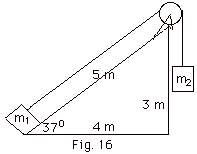 |
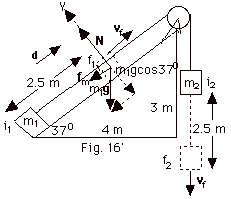 |
We choose different potential energy
positions for the potential energy equal to zero
for m1 and m2. Notice that when
m2 moves down, m1 moves up the
incline. Since we always take the lowest position for the
zero of potential energy, the position of m1
in Fig. 16 (above left) is its lowest position
and we take the potential energy of m1
equal to zero there. The position of m2 in
Fig. 16 is its highest position. Thus we take its zero potential
at a point 2.5 m below where it is in Fig. 16 or its dashed
position in Fig. 16’ (above right). Mechanical
energy is not conserved.
(Fnet)y = m1ay
FN - m1g cos 37o =
m1(0) = 0 or
FN = m1g cos 37o = m1g(4/5).
f = µFN = 0.55(m1g)(4/5) =
0.55(2.0 kg)(10 m/s2)(4/5) = 8.8 N.
The work done by friction = f(d) cos  f,d
= fd cos 180o f,d
= fd cos 180o
= -fd = -8.8 N(2.5 m) = -22 J.
In the final position f2, the potential energy
(U2)f of m2 is zero, but
in the final position f1, the potential energy
for m1 is m1gh1, where
h1 = the vertical height above the initial position.
Since it goes up the plane 2.5 m and the plane is inclined
at 37o, the vertical height h1 =
2.5 m sin 37o = 2.5 m (3/5) =1.5 m.
(U1)f = (m1g)h1 =
(20 N)1.5 m = 30 J. For the system Uf = (U1)f
+ (U2)f = 30 J + 0 = 30 J. Since
both blocks move together, their final speed vf
is the same. The final kinetic energy of the system Kf
= (1/2)(m1 + m2)vf2
= 1/2(6.0 kg) vf2. The initial
potential energy (U1)i of
m1 at i1 is zero.
The initial potential energy of m2
at i2 is (U2)i =
m2g(2.5 m) = (4.0 kg)(10 m/s2)(2.5 m)
= 100 J. For the system, Ui = 100 J.
Both blocks were initially at rest. For the system
Ki = 0. Again,
Work by friction = { Uf
+ Kf
} - { Ui
+ Ki }
-22
J =
{30 J + 3.0 kg(vf2)} - {100 J + 0 }
-22 J - 30 J + 100 J = 48 J = 48 N-m = 3.0 kg
vf2
48 kg-m2/s2 = 3.0 kg vf2
or
vf2 =16 m2/s2
and
vf = 4 m/s
|
|
|
40.
|
 |
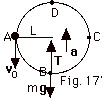 |
- Take UB = 0 and use conservation of energy:
UA
+
KA
=
UD +
KD
mgL
+ 1/2(m)vo2 =
mg2L + 0
or
1/2(m)vo2
= mgL
or
vo = (2gL)1/2
Note: If the ball were attached to a string, it could not
go up to D and stop. A string can only pull in toward the
center of a circle so at the top of the circle, the gravitational
force would cause the ball to fall down. On the other hand,
a rod can provide a force up or down, so when it comes to
rest, the upward force of the rod balances the gravitational
force and the ball returns on its path clockwise.
- At B (Fig. 17’, above right) the acceleration is
up so take up as positive.
Fnet = ma
T - mg = mvB2/L
(Equation
1)
Turn to conservation of energy to find vB.
UA
+ KA
=
UB +
KB
mgL + 1/2(m)vo2 =
0 +
(1/2)mvB2
From (a),
mgL + (1/2)m{(2gL)1/2}2
= 0 + (1/2)mvB2 or
mgL + mgL
=
(1/2)mvB2 or
mvB2 = 4mgL (Equation
2)
Substituting Eq. 2 into Eq. 1,
T - mg = 4mgL/L = 4mg and
T = 5mg
- Work done by frictional force
= (UC + KC) - (UA
+ KA)
= (mgL + 0) - (mgL + mgL)
= mgL - 2mgL
= - mgL
- Work done by frictional force
= (UB + KB) - (UA
+ KA)
= (0 + 0) - (mgL + mgL)
= - 2mgL
|
|
|
41.
|
In our calculations, we are assuming the peg is so small
(even if it is drawn a little larger so you can see it) that
the mass of the rope is essentially that of a rope of length
0.60 m on the right of the peg and 0.40 m on the left of the
peg. The mass per unit length = m/L. The mass of length
dy = (the mass per unit length)dy = (m/L)dy.

In Fig. 18 above, we take the gravitational potential energy
equal to zero at the point where the right end of the rope
hits the ground shown by the horizontal line at the bottom
of the figure. In Fig. 18i, the initial potential energy of
a length dy on the right side of the peg is:
(mass/length dy)(g)(y + 0.40 m) = (m/L)dyg(y +
0.40 m)
One on the left side is:
(mass/length dy)(g)(y + 0.60 m) = (m/L)dyg(y +
0.60m)
For the entire rope,

(0.20 kg)(10 m/s2)/(1.0 m){0.36 m2/2
+ 0.24 m2 + 0.16 m2/2 + 0.24 m2}
= 1.48 J.
When the rope just touches the ground (Fig. 18f), the potential
energy
= Uf = (mg/L){ o∫1.0m
y dy = (0.20 kg)(10 m/s2/(1.0 m){1.0 m2/2}
= 1.00 J.
Since there is no friction, the total mechanical energy is
conserved.
Ui +
Ki = Uf +
Kf
1.48 J + 0 = 1.00 J + 1/2(0.20 kg)vf2
vf2 = (1.48 -1.00)J/0.10 kg = 4.8
(kg m2/s2)/(kg)
vf = 2.2 m/s
|
|
|
42.
|
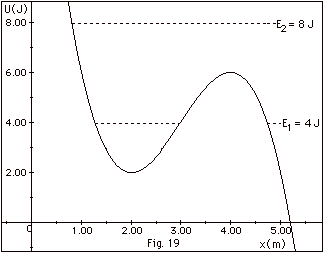
- A particle initially at x = 2.0 m and 2.0 J < E <
6.0 J would be trapped and undergo back-and-forth motion.
For example for E = 4.0 J, the particle would go back
and forth between x = 1.27 m and 3.0 m. See (e) below.
- A particle initially at x = 5.0 m for 2.0 J < E <
6.0 J could move to lower values of x until about x = 4.75
m, then it would experience a repulsive force because F4.75
m = - (dU/dx)at x = 4.75 m >
0, and go off to higher values of x.
- A particle initially at x = 2.0 m and moving to smaller
values of x for
E > 8.0 J experiences a repulsive force, escapes
from the potential well, and moves off forever to the right.
- The potential energy at x = 3.00 m is 4.00 J. E
= U + K. 8.0 J = 4.0 J + K.
K = 4.0 J = 1/2 mv2 = 1/2(2.0 kg)vf2.
vf = (4.0 J/kg)1/2 = (4.0 kg-m2/s2/kg)1/2
= 2.0 m/s.
- At x =1.27m (Fig. 19’ below),
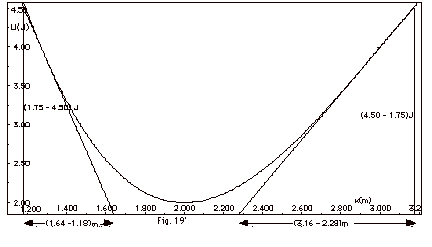
- - slope = - (1.75 -4.50)J/(1.64 -1.18)m
= 6.00 N.
- - dU/dx = -3.00 J/m +3m-1(x m-1
- 3)2 J.
(-dU/dx)x = 1.27m = -3.00 N + 3m-1(1.27
- 3)2 J = 6.00 N.
- At x = 3.00 m,
- - slope = - (4.50 - 1.75)J/(3.16 - 2.28)m
= -3.12 N.
- (-dU/dx)x = 3.00m = - (3.00 N
) + (3)(3 -3)2N = -3.00 N.
3.12 is within the drawing error of 3.00.
|
|
|
43.
|
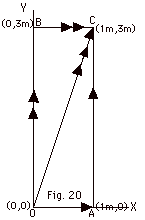
dW = F . ds = 2.0 N/m3(xy2
i +yx2 j)(dx i + dy j)
= 2.0 N/m3(xy2 dx + yx2
dy)
because i . i = j . j
= 1 and
i . j = j . i = 0.
- From O to A, y = dy = 0 and
W = 0.
From A to C, dx = 0 and
x = 1.0 m,
W =(2.0 N/m3) o∫3.0m
y(1.0 m2)dy = 9.0 J.
- From O to B, x = dx = 0 and
W = 0.
From B to C, y = 3.0 m and
dy = 0.
W =(2.0 N/m3) o∫1.0m
x(9.0 m2)dx = 9.0 J.
- From O to C, y = 3.0x and
dy = 3.0dx,
xy2 dx = x(3.0x)2dx = 9.0x3 dx
and
yx2 dy = (3.0x)x2(3.0dx) = 9.0x3
dx.
W = 36 N/m3 o∫1.0m
x3 dx = 9.0 J.
- From O to A to C, W = +9.0 J.
From C to 0, W = - 9.0 J.
From O to A to C to O, W = 0.
- The force appears conservative. The work is independent
of path and equals zero for a closed path.
|
|